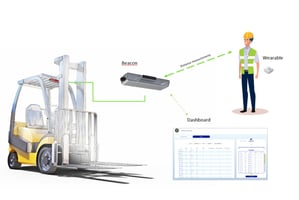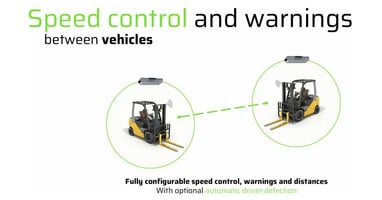Forklift operators must follow all sorts of safety protocols: stopping at all intersections even if...
The Role of Safety Equipment in Warehouse Automation

Warehouse automation is transforming the logistics and manufacturing industries by increasing efficiency, reducing operational costs, and speeding up workflows. However, this transition introduces new challenges in terms of safety.
Since automated systems operate alongside human workers, the workplace dynamic demands careful consideration to prevent accidents. Establish a safe and productive workspace using the proper safety equipment.
With this blog, you’ll gain a deeper understanding of the role of safety equipment in warehouse automation. Discover which tools are necessary and how to use them to protect your workforce, minimize downtime, and improve the overall efficiency of your operations.
Why Safety Is Critical in Warehouses With Automated Systems
With the rapid integration of robots, automated guided vehicles (AGVs), and conveyor systems, most warehouses no longer solely employ human workers. Technological advancements bring plenty of benefits, but they also create environments with the potential for accidents involving heavy machinery, high-speed operations, and overlapping workflows. By investing in high-quality safety equipment, you can prevent risks from becoming costly incidents.
Additionally, safety equipment helps protect the physical well-being of your workforce and the reliability of your operations. Accidents can lead to downtime, damaged goods, and missed deadlines, all of which affect your bottom line. In order to keep your operation running smoothly, fulfill regulatory obligations, and foster trust in the workplace, it’s essential to establish a safe warehouse.
The Key Benefits of Integrating Safety Equipment
1. Protection for Human Workers
Automated environments operate at unparalleled speeds, where human error or inattention can have severe consequences. Safety equipment mitigates risks by creating barriers, warning systems, and responsive mechanisms to keep workers safe.
2. Reduced Downtime
Accidents or near-misses require halting operations for investigation and corrective measures. With safety equipment, you can prevent these interruptions while enabling seamless workflows and uninterrupted production schedules.
3. Enhanced Automation Efficiency
Automation thrives on precision and reliability. Safety equipment complements automation by reducing variable risks, allowing automated systems to function at their full potential without human or mechanical disruptions.
4. Compliance With Safety Regulations
In warehouses, occupational health and safety regulations mandate numerous safety protocols. Safety equipment helps warehouses meet each of the safety requirements as you maintain a responsible, secure work environment.

Examples of Safety Equipment in Warehouse Automation
Safety equipment spans a wide range of technologies and devices, tailored to specific tasks and risks. Below, explore some examples of equipment that can significantly boost safety in automated warehouses.
Forklift Proximity Sensors
Environments where forklifts operate near human workers or other machinery should have a forklift proximity sensor. Using advanced technologies like ultrasound or radio frequency identification (RFID), the sensors detect obstacles or workers in the vehicle’s path. With visual or auditory signals, the proximity sensor can alert the forklift operator or even slow down the machine automatically.
Light Curtains
Light curtains act as virtual barriers to separate automated machinery from human-access areas. When an object or person interferes with the light beams, the system immediately halts the machinery to prevent accidental injuries. These tools are common in robotic arms, conveyors, and palletizing zones.
Emergency Shutoff Systems
Every piece of automated equipment must include a clearly marked and easily accessible emergency shutoff system. In case of an unexpected malfunction or hazardous situation, these systems allow workers to stop machinery instantly.
Safety Mats
Safety mats are pressure-sensitive devices placed in areas where workers need to interact with automated equipment. If someone steps on the mat, it triggers a signal to halt the connected machinery. For loading zones and robotic workstations, safety mats are ideal.
Machine Guarding Systems
Physical barriers like panels or enclosures protect workers from moving parts, pinch points, and flying debris caused by automated systems. The barriers are particularly important to safeguard people from large, high-speed machines.
Noise Reduction Equipment
Automated environments can generate high levels of noise, which may lead to hearing loss over time. Earplugs, earmuffs, and noise-dampening panels maintain worker productivity while creating a safe workplace.
Wearable Safety Devices
Wearable devices, such as vibration sensors or proximity alerts embedded in vests and helmets, alert workers if they’re too close to dangerous machinery or high-risk zones. For employees in extremely automated environments, these devices provide another layer of protection.
Automated Warning Systems
Safety beacons, strobes, and alarms alert workers to moving vehicles, imminent hazards, or active areas. These visual and auditory systems are particularly effective in areas with restricted visibility.

How To Implement Safety Equipment in Your Warehouse
Integrating safety equipment effectively requires a systematic approach that aligns with your automation goals. Implement these tools in your warehouse by following these steps.
Step 1. Conduct a Risk Assessment
Analyze the layout of the warehouse, the types of machinery in use, and the movement patterns of goods and people. Identify high-risk areas that require intervention.
Step 2. Choose the Right Equipment
After the assessment, select safety equipment that addresses the identified risks. For example, high-traffic areas with forklift activity might benefit most from proximity sensors and wearable safety devices.
Step 3. Integrate the Safety Equipment With Automation Systems
Make sure your safety equipment is compatible with your existing automated systems. For optimized effectiveness, many modern tools integrate seamlessly with warehouse management systems (WMS) or Internet of Things (IoT) platforms.
Step 4. Provide Workers With Safety Training
Without adequate training, even the best safety equipment can be ineffective. Educate your workforce on how to use safety equipment, understand warning signals, and respond to emergencies.
Step 5. Schedule Regular Maintenance
Safety equipment is only as good as its reliability. Establish a maintenance schedule to inspect, repair, and replace safety tools, so they function as intended.
Step 6. Monitor and Update Systems
Continually monitor the effectiveness of your safety measures. Upgrade them as the warehouse’s automation systems evolve.
Prioritize Safety for a Secure Warehouse
Warehouse automation is revolutionizing how businesses operate, but it introduces new safety demands. When you understand the role of safety equipment in warehouse automation, you can proactively address issues, protect your employees, and keep operations running smoothly.
To keep your warehouse on track, remember to conduct thorough risk assessments, integrate advanced safety tools, and foster a culture of safety to build an operation that balances innovation with responsibility. Want to make your warehouse safer and more efficient? Explore the safety solutions available on our website. Together, we can create a smarter, safer work environment that benefits everyone.




